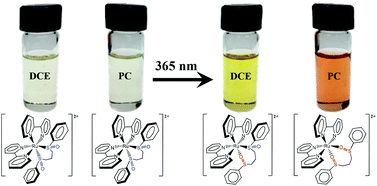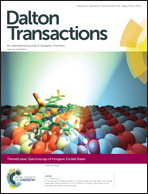Ultrafast spectroscopy and structural characterization of a photochromic isomerizing ruthenium bis-sulfoxide complex†
Abstract
Irradiation of [Ru(bpy)2(bpSOp)](PF6)2 (where bpy is 2,2′-bipyridine and bpSOp is 1,3-bis(phenylsulfinyl)propane) results in the formation of two new isomers, namely the S,O- and O,O-bonded species. The crystal structure of the bis-thioether and bis-sulfoxide complexes are reported. NMR spectroscopy of the bis-thioether complex in solution is consistent with the molecular structure determined by diffraction methods. Further, NMR spectroscopy of the bis-sulfoxide complex reveals two conformers in solution, one that is consistent with the solid state structure and a second conformer showing distortion in the aliphatic portion of the chelate ring. Time-resolved visible absorption spectroscopy reveals isomerization time constants of 91 ps in dichloroethane (DCE) and 229 ps in propylene carbonate (PC). Aggregate isomerization quantum yields of 0.57 and 0.42 have been determined in DCE and in PC, respectively. The kinetics of the thermal reversion from the O,O- to S,O-bonded isomer are strongly solvent dependent, occurring with rates of 2.41 × 10−3 and 4.39 × 10−5 s−1 in DCE, and 4.68 × 10−4 and 9.79 × 10−6 s−1 in PC. The two kinetic components are assigned to the two isomers identified in solution.

- This article is part of the themed collection: Spectroscopy of Inorganic Excited States

 Please wait while we load your content...
Please wait while we load your content...